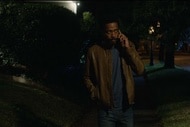Create a free profile to get unlimited access to exclusive videos, sweepstakes, and more!
Exclusive: 'Death of Doctor Strange' writer Jed MacKay on why it took 30 years to pull off the event's big twist

Earlier this year, Marvel Comics made headlines when they announced that one of their most important heroes, Dr. Stephen Strange, would meet his end in an event miniseries appropriately titled The Death of Doctor Strange. Written by Jed MacKay and drawn by Lee Garbett, the event begins this week and not just unpacks the events of Strange's demise, but his larger impact as part of the Marvel Universe, asking the question: When the Sorcerer Supreme goes down, how many things can go wrong?
It's a question we're going to find out the answer to in the coming months, as the event and its various spinoff issues unpack the fallout of Strange's death, the mystery surrounding his murder, and what happens when Marvel's other major players have to try to step up and fill the power void left by the Sorcerer Supreme. The first issue of the much-anticipated miniseries arrived today, and while it definitely brought the expected mysteries and action, it also brought some new twists that we didn't see coming to the saga.
Thankfully, MacKay himself is here to break it all down for us, and offer an exclusive peek at what's to come.
**Spoiler Warning: There are spoilers for The Death of Doctor Strange #1 ahead**
Throughout the first issue of The Death of Doctor Strange event, as Stephen Strange goes through his daily life in New York City — using his newly restored hands for surgery, walking his spectral dog, and dealing with problems on the Strange Academy campus — he meditates on a particular story that helped drive him to do what he does, the story of a man he excised a part of his soul and tucked it away so he could never die.
Over the course of the issue, Strange explains the story as one of his inspirations behind becoming a surgeon and working to cheat death itself, but then the story reveals that it's more than just a parable. It turns out that Stephen Strange has also found a way to preserve a piece of himself to be activated in the event of his death. The moment Doctor Strange dies, another Doctor Strange emerges, looking and sounding much more like Strange did in his comic book debut years ago under writer/artist Steve Ditko than he does now. It's a clever twist, one that's apparently been in the works for decades. In the gallery below, you can get an exclusive peek at what's to come for that incarnation of Strange in The Death of Doctor Strange #2.
And in the Q&A below, we dug into the twist, as MacKay talks about where The Death of Doctor Strange #1 ending came from, what it means, and what happens next.
Walk us through the decision to reveal Stephen Strange has severed a version of himself to be deployed in case of emergency. How did you arrive at that for the series?
That was actually something that was in place when I joined the project. Tom Brevoort had been batting around some ideas for The Death of Doctor Strange for 30 years, and one of them was this idea of a younger Strange appearing from a hidden door in the Sanctum, tucked away for just this sort of disaster. I thought it was a very elegant idea, and took it and ran with it!
How do you see this incarnation of Stephen? Is it Stephen's soul? A fragment of his soul? A projection of his past self?
That is something that we'll get into more fully next issue, but the clues are there- we're looking at Strange that is younger, more in line with his earlier appearances. In #1, Strange explains that this excerpt of Stephen that appears is the result of something that he did when he was much younger. For any more particulars than that, well, you'll have to tune in next month!
What can the group of characters surrounding Stephen expect out of this alternate version of him? Obviously there's a lot of Steve Ditko influence in the way he looks and speaks, so what does that mean for character dynamics in the modern Marvel Universe?
There's necessarily a bit of fudging with the timeline when you bring a character forward from that far back, but we're dealing with a Stephen Strange who hails from the mid-to-late 120s of Strange Tales. A Strange who, compared to the contemporary man who died (and who he will become), is colder, more used to working alone. Time has tempered Stephen Strange greatly, and the Doctor Strange who we follow over the course of this series lacks that.
Similarly, this is a world that this younger Strange doesn't recognize, filled with friends and enemies that he hasn't met yet. And, of course, this is a Doctor Strange who is still the Master of Black Magic, one who has yet to become the Sorcerer Supreme.
Even if a part of Stephen is still alive, there's obviously a lot of fallout to contend with from his apparent death. What can you tease about where issue #2 is headed?
As mentioned in The Death of Doctor Strange #1, the Barrier spell preventing mass invasions from hostile dimensions has fallen, and invasions from the Purple Dimension, Dark Dimension and Sixth Dimension are ongoing. As well, there are other global effects, shockwaves of the Sorcerer Supreme's death that will be explored in the one-shots that come along with the series. From looking at New York in The Death of Doctor Strange: Spider-Man, to England in The Death of Doctor Strange: X-Men/Black Knight, East Asia in The Death of Doctor Strange: White Fox, the vampire nation of Chernobyl in The Death of Doctor Strange: Blade and even other dimensions in The Death of Doctor Strange: Avengers, all put together by some of the most exciting creators in the game (and me).
When the book was announced, a lot of people expected a predictable "This character's dead, but we know he'll be back one day" sort of ride, and you seem to be bucking that with the end of this issue. Was that a conscious break with past "Death of" superhero stories or just the natural progression of this narrative?
By the end of the book, there's Doctor Strange's corpse on the floor, and Doctor Strange standing over it. So we've gotten the whole "he's dead but he'll be back" thing out of the way early so we can get on with the story. Audiences have certain expectations at this point when it comes to superhero death stories, and that's completely understandable, it's just part of the way the medium works. But here's the thing: this book's not called The Life of Doctor Strange.
The Death of Doctor Strange #2 arrives October 20.


























